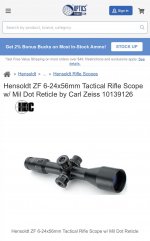Maybe it's my OCD kicking up some dust, but I read the article, so even though I agree w/some of what it tries to say about resolution, I don't go along w/how he says it, so I'll say this....
Resolution is the ability to see 2 objects that are very close together and still being able to see that they are 2 distinct objects via the kind of similar discussions/considerations but different by degree of the Dawes vs Rayleigh limits (and the issue of being able to see a distinct slit bet. the 2 objects).
Also this discussion when talking about "airy disks" and the trail off around their edges caused by wave interference.
Resolution is also a discussion of the ability of an optic to transfer contrast/resolution from the object/object plane to the image plane usually described in graphs as a percentage of contrast via the Modulation Transfer Function.
An optic is pointed @ the 1951 USAF resolution target and it's vision checked kind of like how humans go to the docter's office to get their eyes checked where this target has either black or white on it and the abrupt transitions between the two (the issue of resolution/contrast would also be about defining edges).
The optic being tested tries to reproduce that black and white and the abrupt transitions between the two, but if it can't do it 100% (actually no optic can), it will end up rendering less distinct areas than the test target producing a grey scale, or said another way, it produces an image of the object w/grey areas which are a kind of a blurred/merging together of the original black and white values and this grey/greyscale doesn't exist in the original test target @ the object plane.
This is expressed as a percentage loss in contrast via the MTF.
There's no grey areas/and degree of grey scale in the test target, only black and white, so when the optic can't reproduce that 100%, the optic will then produce areas that change that black and white from the object/object plane to a "muddled grey" and as it gets worse the percentage will keep going down from 100%.
One issue about the way the article discusses all this.....
There's coma-flare-astigmatism-distortion (barrel/pincushion)--------aberration(chromatic[longitudinal-axial]/spherical[positive-negative])-------diffraction limiting-----------------curvature of field, which all to a major or to a limited extent affect resolution regardless of the size of an optics front objective.
Optics/the front objective project images as a "field", which isn't flat, so there's curvature of field, and because of that curvature, and as the central portion registers on the film plane/ chip or whatever, then resolution (and illumination) will drop off to the edges.
So the above is also a consideration of the "drop off" of resolution/illumination from the center to the edges, apart from and in addition to the idea of an airy disk which "trails off" to the edges because of "wave" interference.
YES, taking an image of a point light source like a distant star is going to produce an "airy disk" because of the trail off due to the wave interference caused in the optical system taking the image.
It's all of the problems in a system that limit the resolution of a system, not just the math indicating what the front objective is doing.
So while the article does in fact touch on all of this the way it does, I don't believe that you can turn around and suggest that a 56mm objective is some kind of brick wall.
BOTTOM LINE; any claim of an optic reaching any kind of theoretical limit or how it should perform, should be backed up by lab testing by professionals documenting how the optic actually performs.
I have a Mamiya 100-200 MF Zoom, which looked very sharp when I looked through it. Despite that, years ago, I had a spirited debate w/a guy who suggested that this optic could not be very sharp and presented some very involved math to back that up.
It was a waste of time to keep arguing about it, so I took the lens to a friend of mine who's also a Rollei repair tech and he slapped the lens on his collimator and announced to me that it was one of the sharpest lenses he's ever tested, and he's tested Rollei and Carl Zeiss.
Your math can be correct, you can still be wrong via leaving out something/some aspect you should've included in your calculations, or the reverse, by extending your calculations beyond a specific point to include something where the math really doesn't apply.
I don't agree at all w/his suggestion about testing optics which should be done by the best professionals who've spent a career in testing optics; ditto getting a comprehensive examination of your eyesight at somewhere like the Stein inst. re whether any particular problem is on UR end.
Somebody like Koshkin who tests resolution every day would probably have the most detailed nuance about this, but what struck me about what he said touched on my belief that God is obviously the greatest lens designer in the universe. He took his sweet time and millions of years to get it right and the rest of us are playing "catch-up".



